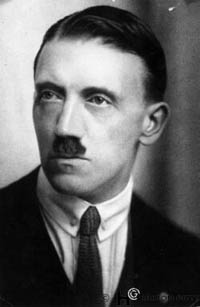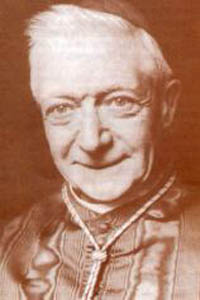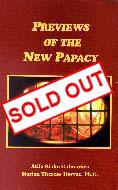 |
Consequences of Vatican II
Munich, Wansee and Vatican II
Lyle J. Arnold, Jr.

Hitler at the beginning of his career |
On Thursday evening, November 8th 1923, at the Buergerbraukeller beer hall in Munich, Bavarian Commissar Gustav von Kahr (who wanted to restore the monarchy) was addressing thousands of beer-drinking burghers. S.A. troops surrounded the hall, and machine guns were being set up at the entrances. Hitler pushed into the hall, pointed a pistol at the head of a policeman who sought to intervene, jumped on a table, and took over the speaking, shouting, "The National Revolution has begun!"(1)
On Saturday, October 13th 1962, the third day of the Second Vatican Council and the anniversary of the Miracle of the Sun at Fatima), Cardinal Achille Lienart seized the microphone from the speaker, who was addressing thousands of the hierarchy and their periti, and squelched the three years of groundwork of the preparatory schemas (which would have retained the monarchial structure of the Church). No S.A. or guns were needed, only the use of raw, dirty, power-grabbing. Once accomplished, the takeover transfered the leadership of the Council to the liberal Bishops of the Rhine countries.' (2) The "Johannine revolution" had begun. (3)
On January 20th 1942, in the Berlin suburb of Wannsee, 15 officials were seated to confront the Jewish problem that was menacing the Third Reich and to receive instructions about the final solution. (4) Two decades later, on October 11, 1962, the Council fathers were seated to confront the problem of the monarchial Church that was, in the minds and hearts of the Church's enemies, menacing the world. Just before this, a mini-council was held at Metz, France, where a deal was cut: as a sop to Communism, the Council would be apolitical.

Cardinal Achille Lienart |
Both of the above affairs operated malo amino (with bad spirit) following the modern ideal. Modern man believes politics to be "power, rule and authority."(5) Catholic teaching, however, knowing that the Kingdom of Christ extends beyond its spiritual nature to political things (6), readily adheres to Aristotelian thinking. Aristotle rightly envisioned politics to be so important to man's welfare that he called it an art. And because it directs the whole of a society and all man's endeavors, he deemed it the "master art."(7)
The Council fathers well knew that the politics of the the temporal sphere is not separated from the spiritual sphere. The first operates in the realm of "principalities and the powers, against the rulers of this world of darkness" (Eph. 6: 12). In support of this, a famous exorcist declared that today, in some countries, there are leaders in high public offices who are demonically possessed. (8) By declaring the Council to be "apolitical," they not only directly followed the method of the Nazis in their use of power, rule and authority, they bowed to the Communists who killed more people than the Nazis.
The Council fathers went a step further by using shameless trickery. This was the lie that proclaimed the Council to be pastoral, when in fact it segued directly into the doctrinal. (9) The state of the new church is governed by the heretical doctrine of Progressivism (pawned as truth to the people of God), but maintained by power, rule and authority. By the practice of ecumenism, the progressivists have caused the souls of so many Catholics to surrender adhesion to the very foundation of Faith: the understanding that on the axis of life, Catholics are on one pole, and the world is on the other.
1. William L. Shirer, The Rise and Fall of the Third Reich(NY: Simon and Schuster, 1960), p. 68.
2 Christopher A. Ferrara, Thomas E. Woods, Jr., The Great Facade (Minnesota: Remnant Press, 2002), p. 70.
3. Thomas Bokenkotter, A Concise History of the Catholic Church (NY: Image Books, 1979), p. 416.
4. The Wannsee Protocol is a document in the public domain, and can be read by entering the term on Google.
5. Robert A. Dahl, Modern Political Analysis (Yale University, 1963).
6. Pietro Parente, Antonio Piolanti, Salvatore Garofalo, Dictionary of Dogmatic Theology (Milwaukee: Bruce Publishing Company, 1951), p. 162.
7. Aristotle, Politics, Nicomachean Ethics.
8. Malachi Martin, The Kingdom of Darkness (Toronto: Triumph Communications), p. 9.
9. Atila Sinke Guimaraes, In the Murky Waters of Vatican II (MAETA, 1997), 167-168.

Posted May 7, 2007

Related Topics of Interest
 Liberals, Modernists and Progressivists Liberals, Modernists and Progressivists
 Carefully Taught Catholics Carefully Taught Catholics
 Resisting the Novelties of the Conciliar Church Resisting the Novelties of the Conciliar Church
 The Council of Metz The Council of Metz
 Card. Ratzinger: Gaudium et Spes is a Counter-Syllabys Card. Ratzinger: Gaudium et Spes is a Counter-Syllabys
 The Growing Rejection of Vatican II The Growing Rejection of Vatican II
 The Spider The Spider
 How a Catholic Should Act in Face of Bad Popes How a Catholic Should Act in Face of Bad Popes



|
Vatican II | Hot Topics | Home | Books | CDs | Search | Contact Us | Donate

© 2002-
Tradition in Action, Inc. All Rights Reserved
|
 |
|